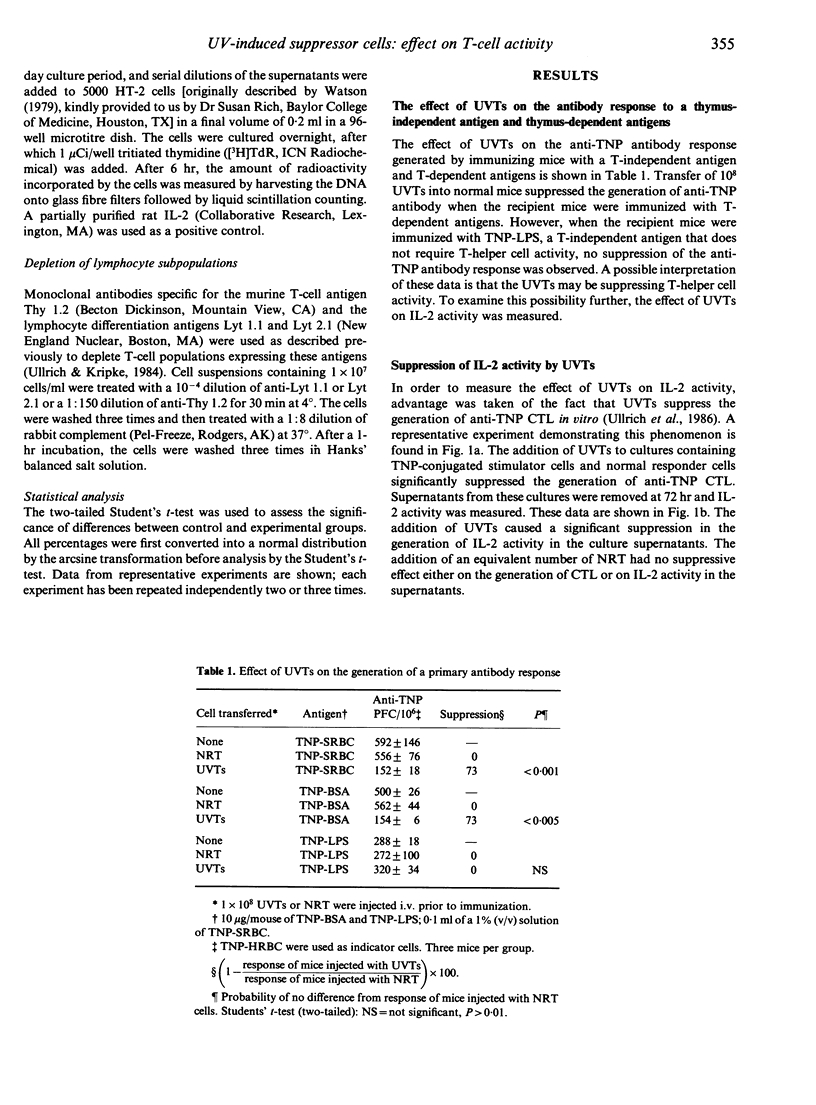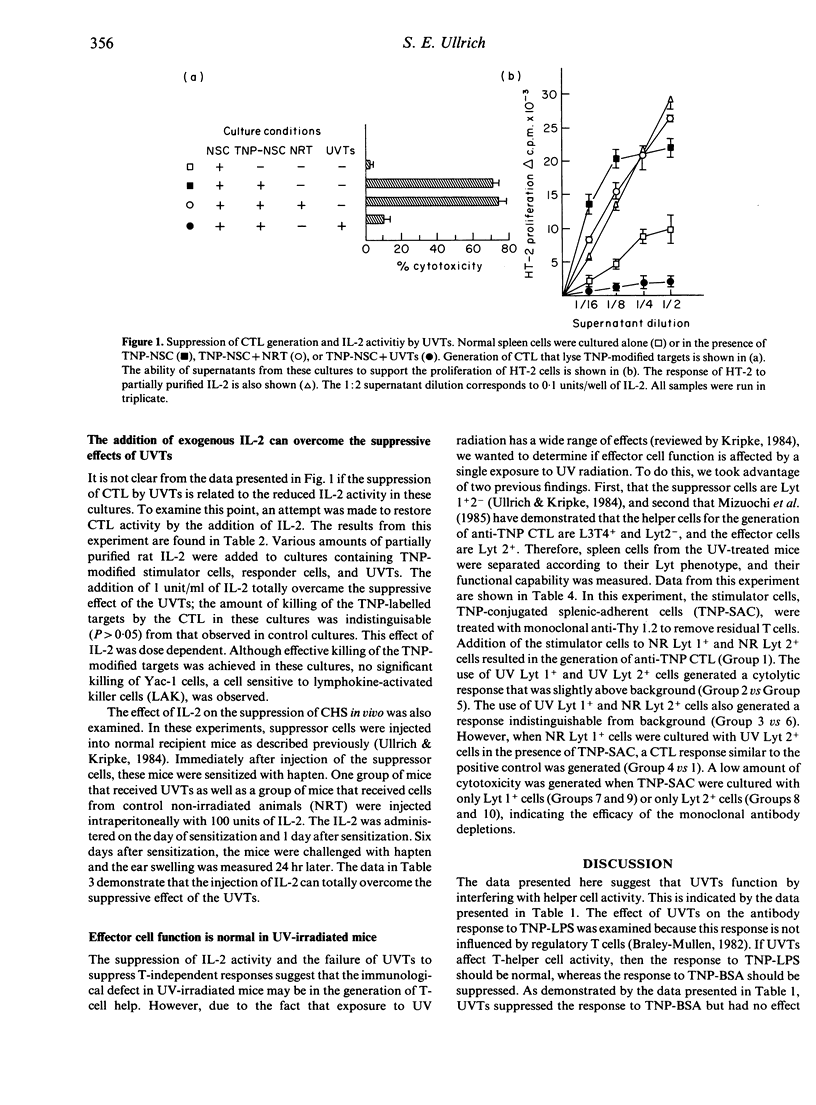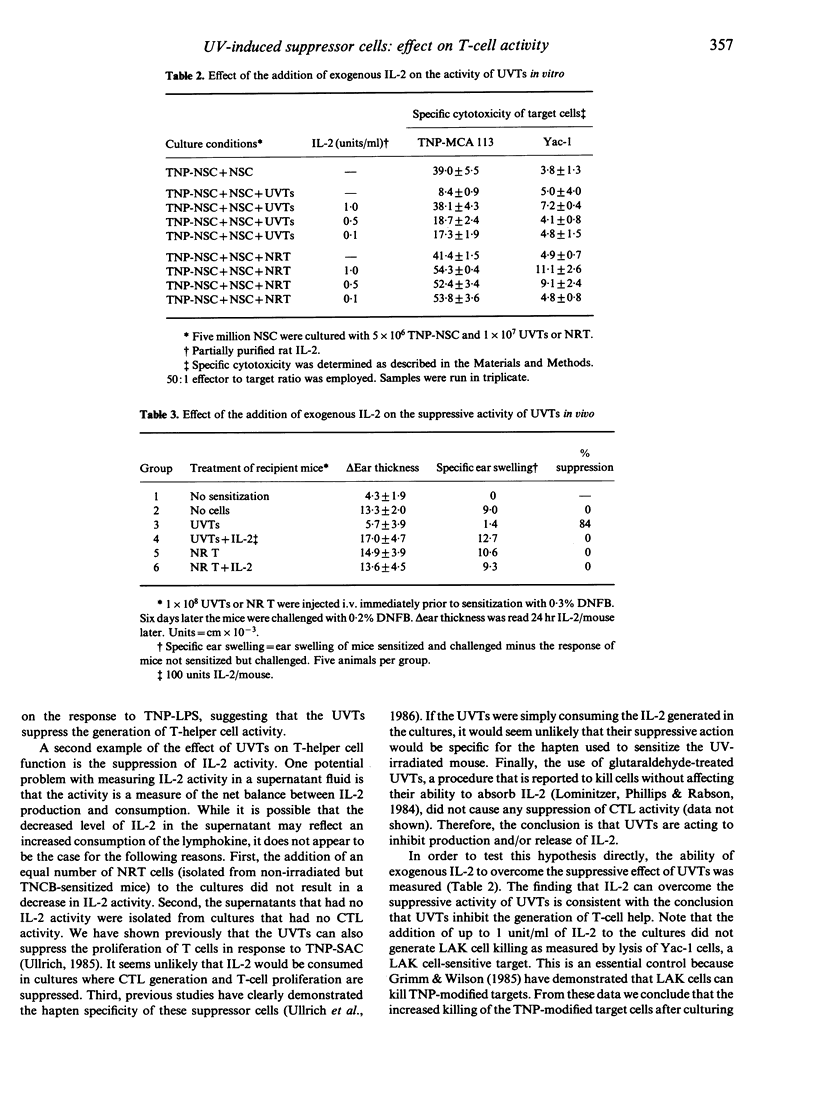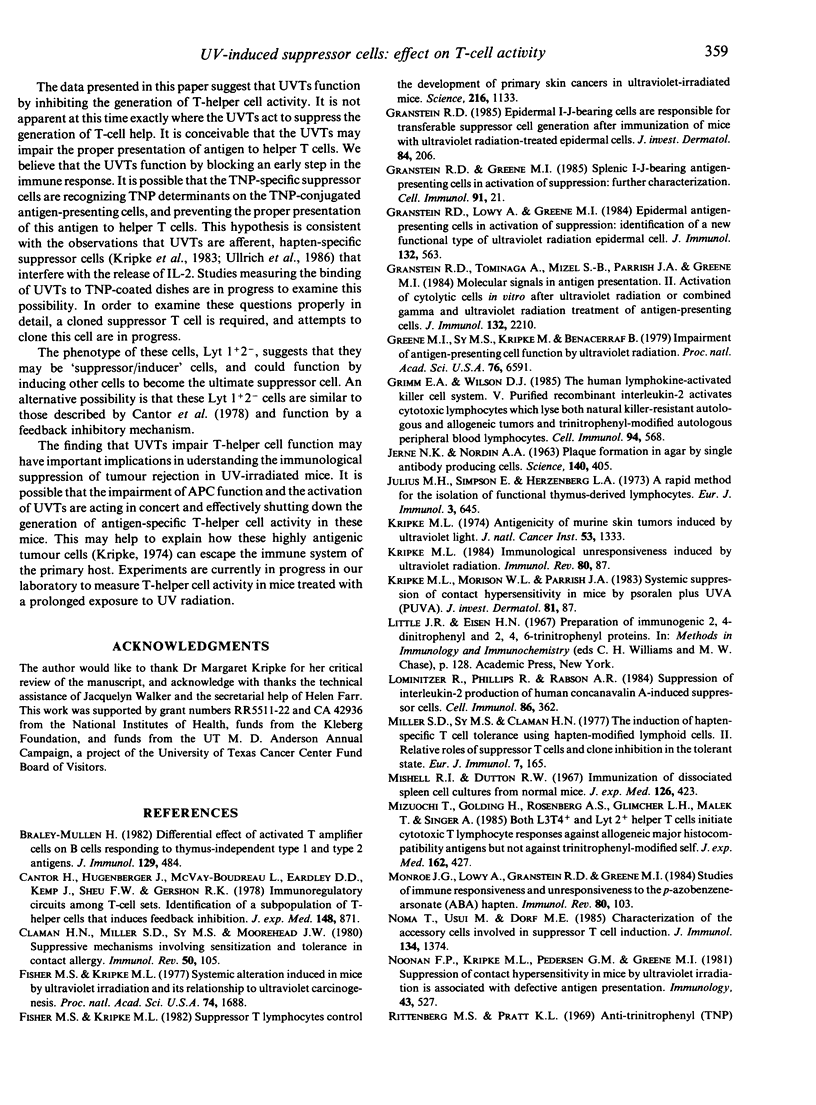Abstract
The suppression of contact hypersensitivity (CHS) after a single exposure to ultraviolet (UV) radiation provides an excellent model system with which to study both the activation and the mode of action of suppressor T cells. Suppression of CHS after UV radiation is mediated by hapten-specific suppressor T cells (UVTs). These cells have a broad range of activity: CHS and antibody production in vivo and the generation of cytolytic T lymphocytes (CTL) and T-cell proliferative responses in vitro are suppressed by UVTs. The present study is concerned with determining the target of UVTs. The UVTs could suppress the response to hapten-modified T-dependent antigens, such as trinitrophenyl (TNP)-modified sheep erythrocytes (TNP-SRBC) or TNP-conjugated bovine serum albumin (TNP-BSA), but had no suppressive effect on the response to a T-independent antigen, TNP-conjugated lipopolysaccharide (TNP-LPS). The UVTs also suppressed the generation of interleukin-2 (IL-2) in vitro. The suppression of CTL generation in vitro and CHS in vivo could be overcome by the addition of exogenous IL-2. These data suggest that UVTs suppress the immune response by affecting T-helper cell function.
Full text
PDF







Selected References
These references are in PubMed. This may not be the complete list of references from this article.
- Bloom E. T., Babbitt J. T. Monocyte-mediated augmentation of human natural cell-mediated cytotoxicity. Cell Immunol. 1985 Mar;91(1):21–32. doi: 10.1016/0008-8749(85)90028-0. [DOI] [PubMed] [Google Scholar]
- Braley-Mullen H. Differential effect of activated T amplifier cells on B cells responding to thymus-independent type 1 and type 2 antigens. J Immunol. 1982 Aug;129(2):484–489. [PubMed] [Google Scholar]
- Cantor H., Hugenberger J., McVay-Boudreau L., Eardley D. D., Kemp J., Shen F. W., Gershon R. K. Immunoregulatory circuits among T-cell sets. Identification of a subpopulation of T-helper cells that induces feedback inhibition. J Exp Med. 1978 Oct 1;148(4):871–877. doi: 10.1084/jem.148.4.871. [DOI] [PMC free article] [PubMed] [Google Scholar]
- Claman H. N., Miller S. D., Sy M. S., Moorhead J. W. Suppressive mechanisms involving sensitization and tolerance in contact allergy. Immunol Rev. 1980;50:105–132. doi: 10.1111/j.1600-065x.1980.tb00309.x. [DOI] [PubMed] [Google Scholar]
- Fisher M. S., Kripke M. L. Suppressor T lymphocytes control the development of primary skin cancers in ultraviolet-irradiated mice. Science. 1982 Jun 4;216(4550):1133–1134. doi: 10.1126/science.6210958. [DOI] [PubMed] [Google Scholar]
- Fisher M. S., Kripke M. L. Systemic alteration induced in mice by ultraviolet light irradiation and its relationship to ultraviolet carcinogenesis. Proc Natl Acad Sci U S A. 1977 Apr;74(4):1688–1692. doi: 10.1073/pnas.74.4.1688. [DOI] [PMC free article] [PubMed] [Google Scholar]
- Granstein R. D. Epidermal I-J-bearing cells are responsible for transferable suppressor cell generation after immunization of mice with ultraviolet radiation-treated epidermal cells. J Invest Dermatol. 1985 Mar;84(3):206–209. doi: 10.1111/1523-1747.ep12265141. [DOI] [PubMed] [Google Scholar]
- Granstein R. D., Lowy A., Greene M. I. Epidermal antigen-presenting cells in activation of suppression: identification of a new functional type of ultraviolet radiation-resistant epidermal cell. J Immunol. 1984 Feb;132(2):563–565. [PubMed] [Google Scholar]
- Granstein R. D., Tominaga A., Mizel S. B., Parrish J. A., Greene M. I. Molecular signals in antigen presentation. II. Activation of cytolytic cells in vitro after ultraviolet radiation or combined gamma and ultraviolet radiation treatment of antigen-presenting cells. J Immunol. 1984 May;132(5):2210–2217. [PubMed] [Google Scholar]
- Greene M. I., Sy M. S., Kripke M., Benacerraf B. Impairment of antigen-presenting cell function by ultraviolet radiation. Proc Natl Acad Sci U S A. 1979 Dec;76(12):6591–6595. doi: 10.1073/pnas.76.12.6591. [DOI] [PMC free article] [PubMed] [Google Scholar]
- Grimm E. A., Wilson D. J. The human lymphokine-activated killer cell system. V. Purified recombinant interleukin 2 activates cytotoxic lymphocytes which lyse both natural killer-resistant autologous and allogeneic tumors and trinitrophenyl-modified autologous peripheral blood lymphocytes. Cell Immunol. 1985 Sep;94(2):568–578. doi: 10.1016/0008-8749(85)90280-1. [DOI] [PubMed] [Google Scholar]
- JERNE N. K., NORDIN A. A. Plaque formation in agar by single antibody-producing cells. Science. 1963 Apr 26;140(3565):405–405. [PubMed] [Google Scholar]
- Julius M. H., Simpson E., Herzenberg L. A. A rapid method for the isolation of functional thymus-derived murine lymphocytes. Eur J Immunol. 1973 Oct;3(10):645–649. doi: 10.1002/eji.1830031011. [DOI] [PubMed] [Google Scholar]
- Kripke M. L. Antigenicity of murine skin tumors induced by ultraviolet light. J Natl Cancer Inst. 1974 Nov;53(5):1333–1336. doi: 10.1093/jnci/53.5.1333. [DOI] [PubMed] [Google Scholar]
- Kripke M. L. Immunological unresponsiveness induced by ultraviolet radiation. Immunol Rev. 1984 Aug;80:87–102. doi: 10.1111/j.1600-065x.1984.tb00496.x. [DOI] [PubMed] [Google Scholar]
- Kripke M. L., Morison W. L., Parrish J. A. Systemic suppression of contact hypersensitivity in mice by psoralen plus UVA radiation (PUVA). J Invest Dermatol. 1983 Aug;81(2):87–92. doi: 10.1111/1523-1747.ep12542071. [DOI] [PubMed] [Google Scholar]
- Lomnitzer R., Phillips R., Rabson A. R. Suppression of interleukin-2 production by human concanavalin A-induced suppressor cells. Cell Immunol. 1984 Jul;86(2):362–370. doi: 10.1016/0008-8749(84)90391-5. [DOI] [PubMed] [Google Scholar]
- Miller S. D., Sy M. S., Claman H. N. The induction of hapten-specific T cell tolerance using hapten-modified lymphoid membranes. II. Relative roles of suppressor T cells and clone inhibition in the tolerant state. Eur J Immunol. 1977 Mar;7(3):165–170. doi: 10.1002/eji.1830070310. [DOI] [PubMed] [Google Scholar]
- Mishell R. I., Dutton R. W. Immunization of dissociated spleen cell cultures from normal mice. J Exp Med. 1967 Sep 1;126(3):423–442. doi: 10.1084/jem.126.3.423. [DOI] [PMC free article] [PubMed] [Google Scholar]
- Mizuochi T., Golding H., Rosenberg A. S., Glimcher L. H., Malek T. R., Singer A. Both L3T4+ and Lyt-2+ helper T cells initiate cytotoxic T lymphocyte responses against allogenic major histocompatibility antigens but not against trinitrophenyl-modified self. J Exp Med. 1985 Aug 1;162(2):427–443. doi: 10.1084/jem.162.2.427. [DOI] [PMC free article] [PubMed] [Google Scholar]
- Monroe J. G., Lowy A., Granstein R. D., Greene M. I. Studies of immune responsiveness and unresponsiveness to the p-azobenzenearsonate (ABA) hapten. Immunol Rev. 1984 Aug;80:103–131. doi: 10.1111/j.1600-065x.1984.tb00497.x. [DOI] [PubMed] [Google Scholar]
- Noma T., Usui M., Dorf M. E. Characterization of the accessory cells involved in suppressor T cell induction. J Immunol. 1985 Mar;134(3):1374–1380. [PubMed] [Google Scholar]
- Noonan F. P., Kripke M. L., Pedersen G. M., Greene M. I. Suppression of contact hypersensitivity in mice by ultraviolet irradiation is associated with defective antigen presentation. Immunology. 1981 Jul;43(3):527–533. [PMC free article] [PubMed] [Google Scholar]
- Rittenberg M. B., Pratt K. L. Antitrinitrophenyl (TNP) plaque assay. Primary response of Balb/c mice to soluble and particulate immunogen. Proc Soc Exp Biol Med. 1969 Nov;132(2):575–581. doi: 10.3181/00379727-132-34264. [DOI] [PubMed] [Google Scholar]
- Shearer G. M. Cell-mediated cytotoxicity to trinitrophenyl-modified syngeneic lymphocytes. Eur J Immunol. 1974 Aug;4(8):527–533. doi: 10.1002/eji.1830040802. [DOI] [PubMed] [Google Scholar]
- Spellman C. W., Daynes R. A. Modification of immunological potential by ultraviolet radiation. II. Generation of suppressor cells in short-term UV-irradiated mice. Transplantation. 1977 Aug;24(2):120–126. doi: 10.1097/00007890-197708000-00005. [DOI] [PubMed] [Google Scholar]
- Tominaga A., Lefort S., Mizel S. B., Dambrauskas J. T., Granstein R., Lowy A., Benacerraf B., Greene M. I. Molecular signals in antigen presentation. I. Effects of interleukin 1 and 2 on radiation-treated antigen-presenting cells in vivo and in vitro. Clin Immunol Immunopathol. 1983 Nov;29(2):282–293. doi: 10.1016/0090-1229(83)90030-2. [DOI] [PubMed] [Google Scholar]
- Ullrich S. E., Kripke M. L. Mechanisms in the suppression of tumor rejection produced in mice by repeated UV irradiation. J Immunol. 1984 Nov;133(5):2786–2790. [PubMed] [Google Scholar]
- Ullrich S. E. Suppression of lymphoproliferation by hapten-specific suppressor T lymphocytes from mice exposed to ultraviolet radiation. Immunology. 1985 Feb;54(2):343–352. [PMC free article] [PubMed] [Google Scholar]
- Ullrich S. E., Yee G. K., Kripke M. L. Suppressor lymphocytes induced by epicutaneous sensitization of UV-irradiated mice control multiple immunological pathways. Immunology. 1986 Jun;58(2):185–190. [PMC free article] [PubMed] [Google Scholar]
- Watson J. Continuous proliferation of murine antigen-specific helper T lymphocytes in culture. J Exp Med. 1979 Dec 1;150(6):1510–1519. doi: 10.1084/jem.150.6.1510. [DOI] [PMC free article] [PubMed] [Google Scholar]


